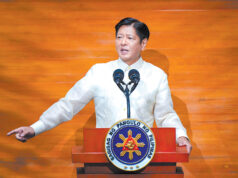Tech’s pervasive influence and the enduring need for reforms, collaboration
Winning together in the fourth industrial revolution
For a discussion about the industries of real estate, transportation and logistics in relation to the technologies driving the Fourth Industrial Revolution, several important people from the public and private sectors came together at the first-ever BusinessWorld IR 4.0 Summit held last Sept. 9 in Taguig City.
They were Brian Cu, country head of Grab Philippines; Ibarra Paulino, executive director of the Philippine Constructors Association (PCA); Runel Taningco, head of the infrastructure and communications technology division at the Housing and Land Use Regulatory Board (HLURB); Techie Bautista, vice-president for academic affairs at the Chamber of Real Estate and Builders’ Associations (CREBA); Emmanuel Estrada, network strategy head of Globe Telecom; and Lester Michael Hernandez, head of solutions at AGS Consulting, an ePLDT company.
Grab, which Mr. Cu said has evolved from a simple ride-hailing app into “an everyday super app” (because one can now order food and send parcels via the app), has disrupted the local transportation industry, providing commuters with new ways to get from one destination to another.
“What’s really exciting is the amount of data that we’ve collected over the years, seeing how we can support this fourth industrial revolution to really transform the way transit is done in ultra-highly urbanized cities,” he said.
He noted that they’ve been working with local government units to help ease traffic congestion, adding that the average travel time of a GrabCar has increased from “around 37 minutes a couple years back” to “40-plus minutes despite the average distance not increasing.” “So we do know that streets are getting more congested,” Mr. Cu said. The question now is “how do we use the data that we have, the technology platforms that we have to help alleviate congestion,” he said. One of the company’s current services, GrabShare, is an attempt at decongestion, aiming “to put more passengers in the same amount of cars without increasing the number of cars on the road….”
When it comes to the development of smart cities, or places powered by information and communication technologies, one crucial factor is the availability of land, according to Ms. Bautista of CREBA. “CREBA has always been at the forefront of trying to advocate for the passage of the National Land Use Act because this will define the uses of the various lands in the Philippines,” she said. As it stands, how a piece of land is used “is always upon subject to negotiation, specifically with local government. And because of that, in the absence of a clear definition of the uses of specific land, it becomes very difficult, very time-consuming, and very, very costly.”
Meanwhile, Mr. Estrada of Globe remarked on the importance of building “intelligent residential communities” as well as the centrality of digital connectivity to that endeavor. “It’s also important that we reach out to the likes of CREBA, the real estate developers, and make sure they are on the same page as us, that they have the same vision of how an intelligent community really can be powered by technology,” he said.
Hoping to bridge the “disconnect” between the academe and the construction industry when it comes to skills, Mr. Paulino of PCA said they are working with the Department of Education, Commission on Higher Education and some universities to improve the curricula of engineering and architecture courses.
Mr. Hernandez of AGS, meanwhile, emphasized the need for organizations to assess themselves — where they are going and how they are going to move forward — in order to achieve their digital transformation goals.
And for Mr. Taningco of HLURB, the information technology projects of the government should be fast-tracked and the manner in which they are funded be improved.



